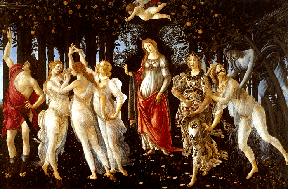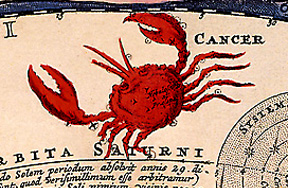Orion was a great hunter.
Courtesy of Corel Corporation
Orion
The ancient Greeks saw the figure of the Greek myth Orion in the nighttime sky. There are several different stories about the birth of Orion. According to one version of the myth, Orion
was the son of a poor shepherd called Hyrieus. Once, Zeus, Hermes, and Poseidon stopped by Hyrieus'house. Hyrieus was so generous with his guests that he killed the only animal he had-an ox.
Hyrieus was not aware that his guests were gods. The gods wanted to reward Hyrieus'generosity by granting him a wish. Hyrieus' biggest desire was to have a child. The gods told him to bury the hide of the bull he had sacrificed to them and to pee on it. After nine months, a boy was born in that place. The child became a very handsome and strong man.
He was such a good hunter that he was hired by the king Oenopion to kill the ferocious beasts that were terrifying the habitants of the island Chios. Happy for his success, Orion said he would kill all the wild animals on the earth.
But. the earth goddess Gaia, who was the mother of all animals, was not pleased with Orion's intention.
Then, Gaia set an enormous scorpion on Orion. Orion soon realized that his
strength and sword were useless against that mighty beast. He tried to escape,
but the scorpion stung him to death. As a reward, Gaia placed the scorpion in the sky
as a constellation which appears to be constantly chasing after Orion
whose figure was also placed among the stars.
You might also be interested in:

According to the ancient Greeks, the Pleiades were seven sisters. In Greek, the word "pleiades" means "doves." Their parents were Pleione and Atlas who was condemned by Zeus to support the Heavens on his
...more
Ahsonnutli was the sky father and chief god for the Navajo. He created heaven, Earth, and the sky. Each of the four directions, or cardinal points, are supported by a giant. Each direction is symbolized
...more
Amphitrite was one of the sea-nymphs called the Nereids. One day the sea god Poseidon saw her dancing and fell desperately in love with her. He promptly asked her to marry him but unfortunately she refused.
...more
Aphrodite was the Greek goddess of love and beauty. She was known to the Romans as Venus. To the perfection of her figure and the purity of her features she added an innocent grace. On her sweet face she
...more
In Greek mythology, Apollo was the son of Jupiter(in Greek Zeus) and Leto (Letona). He was the god of the Sun, logic, and reason, and was also a fine musician and healer. Leto travelled all over Greece
...more
According to an ancient Greek legend, the figure of a gigantic crab was placed in the nighttime sky by the goddess Hera to form the constellation Cancer. Hera swore to kill Heracles, the most famous Greek
...more
In the Northern Hemisphere sky is the constellation Cepheus, king of Ethiopia, and that of his wife Cassiopeia. Cassiopeia claimed that she and her daughter Andromeda were more beautiful than the sea nymphs,
...more















